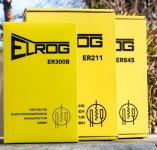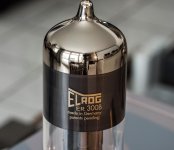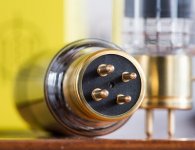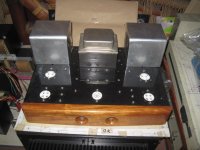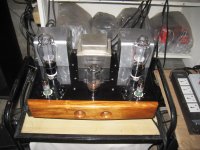Are there sonic differences between them. I have 45's, 2a3's but no 300 b's. Am I missing something. Starting another build and need to make a decision.
The #45 and 2A3 are honest. The 300B is a "showman". Lots of folks like the 300B's euphony, but it (IMO) generates excessive 2nd order harmonic distortion.
If you want 2A3 linearity, along with 300B power, use an unbypassed cathode bias resistor and purchase O/P "iron" that meshes with the increased O/P impedance present.
BTW, you will need DC heating in a SE setup. Cancellation in the O/P trafo allows AC heating to work well in a PP setup.
If you want 2A3 linearity, along with 300B power, use an unbypassed cathode bias resistor and purchase O/P "iron" that meshes with the increased O/P impedance present.
BTW, you will need DC heating in a SE setup. Cancellation in the O/P trafo allows AC heating to work well in a PP setup.
2a3 it is. I don't need more volume.
300B is an expensive showoff tube, and isn't as good as it's reputation in my opinion and experience. 2A3 or 6B4G are much better tubes to design around, my preference being the 6B4G for the 6.3 volt heater which makes it a bit easier to use toroids like antek that come with multiple 6.3 volt windings, so you can save money without cutting corners. But, if you already have suitable tubes, build away!
What kind of amplifier are you going to build next, Push Pull or Single Ended?
I have built 300B Push Pull amps that have almost no 2nd harmonic distortion,
and almost no 2nd order intermodulation distortion. Surprised?
Even some Single Ended 300B amps have low 2nd harmonic distortion. It depends on the plate voltage, plate current, grid bias, transformer primary impedance, and especially not designing it to squeeze too much power out of it.
Unfortunately many use the 300B to get more power, not to get more finesse.
I have built SE 45 amps. But getting quality pairs or quads is hard.
I might build parallel 45 amps if I could get inexpensive NOS tubes that match well.
Dollars per watt adds up when you have to use 2 or 4 each 45 tubes per mono block.
I have built 2A3, 6B4G, and 6A3 amps. Some of the 6A3 and 2A3 tubes were not strictly made to original design, they were made as mono plates.
I would probably build more 2A3 amps if they did not need 2.5 Amps for the filaments (I use DC filaments, and Parallel 2A3 or Push Pull 2A3 amps, plus 2 amps for stereo is 10 Amps. I use individual self bias, so that is 4 each 2.5 Amp DC supplies.
I believe that 2.5V DC filaments are superior to 5V DC filaments, because the current is spread more evenly across the tube's plate(s).
I have built 300B Push Pull amps that have almost no 2nd harmonic distortion,
and almost no 2nd order intermodulation distortion. Surprised?
Even some Single Ended 300B amps have low 2nd harmonic distortion. It depends on the plate voltage, plate current, grid bias, transformer primary impedance, and especially not designing it to squeeze too much power out of it.
Unfortunately many use the 300B to get more power, not to get more finesse.
I have built SE 45 amps. But getting quality pairs or quads is hard.
I might build parallel 45 amps if I could get inexpensive NOS tubes that match well.
Dollars per watt adds up when you have to use 2 or 4 each 45 tubes per mono block.
I have built 2A3, 6B4G, and 6A3 amps. Some of the 6A3 and 2A3 tubes were not strictly made to original design, they were made as mono plates.
I would probably build more 2A3 amps if they did not need 2.5 Amps for the filaments (I use DC filaments, and Parallel 2A3 or Push Pull 2A3 amps, plus 2 amps for stereo is 10 Amps. I use individual self bias, so that is 4 each 2.5 Amp DC supplies.
I believe that 2.5V DC filaments are superior to 5V DC filaments, because the current is spread more evenly across the tube's plate(s).
I agree that there is a difference between 2A3s and 300Bs but I have found much more difference in the choice of driver tube and the type of driver circuit than I ever did between power tube types. That, for me, is for either triode or pentode outputs. Little relative difference.
If you change the driver tube or circuit it's a new amp. Maybe it's speaker dependent.
If you change the driver tube or circuit it's a new amp. Maybe it's speaker dependent.
300B made by Elrog VinylSavor in Germany are interesting triode
something in between 2A3 and Wester Electric classic.
VinylSavor: 300B
🙂
something in between 2A3 and Wester Electric classic.
VinylSavor: 300B
🙂
Attachments
I agree, the driver tube type and circuit values makes a big difference.
One simple 300B amp I have uses DC on the 300B filament, there is a self bias resistor with a bypass cap, and the OPT is 3000 Ohms. It was driven by RC coupling from the driver.
The driver has a self bias resistor with a bypass cap. The plate load is a constant current source. I started with one 1/2 of an Amperex PQ 6DJ8. Then I changed to 1/2 of a Svetlana 6N1P.
The self bias voltage stayed exactly the same, the current stayed exactly the same, the gain stayed almost exactly the same, and only the plate voltage changed.
But Wow! What a difference in the sound!
The 6DJ8 had a lower plate voltage, as would be expected because of it's lower plate resistance. The 6N1P plate voltage was higher because of the higher plate resistance.
The 6DJ8 did have enough plate voltage to swing low and get the 300B all the way to cut off (of course we do not do that except on the test bench, we do not listen to it that way.
But it was going non-linear at that point, just as the 300B was also going non-linear.
On the other hand, the 6N1P had lots of room for swing down to the 300B cut-off point.
I really liked the sound of the 6N1P and 300B in that amp.
I will have to get a Sovtek 6N1P and try it there too.
Another circuit with 6N1P and 300B may not sound good at all.
One simple 300B amp I have uses DC on the 300B filament, there is a self bias resistor with a bypass cap, and the OPT is 3000 Ohms. It was driven by RC coupling from the driver.
The driver has a self bias resistor with a bypass cap. The plate load is a constant current source. I started with one 1/2 of an Amperex PQ 6DJ8. Then I changed to 1/2 of a Svetlana 6N1P.
The self bias voltage stayed exactly the same, the current stayed exactly the same, the gain stayed almost exactly the same, and only the plate voltage changed.
But Wow! What a difference in the sound!
The 6DJ8 had a lower plate voltage, as would be expected because of it's lower plate resistance. The 6N1P plate voltage was higher because of the higher plate resistance.
The 6DJ8 did have enough plate voltage to swing low and get the 300B all the way to cut off (of course we do not do that except on the test bench, we do not listen to it that way.
But it was going non-linear at that point, just as the 300B was also going non-linear.
On the other hand, the 6N1P had lots of room for swing down to the 300B cut-off point.
I really liked the sound of the 6N1P and 300B in that amp.
I will have to get a Sovtek 6N1P and try it there too.
Another circuit with 6N1P and 300B may not sound good at all.
i used the D3a, and other tv video output pentodes, connected as triodes.....
they were so good...
they were so good...
I have built 300B Push Pull amps that have almost no 2nd harmonic distortion,
and almost no 2nd order intermodulation distortion. Surprised?
Not surprising at all.
The reason has a natural explanation, any component or circuit producing intrinsically 2H will, when used in a symmetric circuitry such as PP, or LTP, inevitably transpose any 2H into 3H.
I wish I had as good a success at running AC filaments on 2A3s as you.
The 2A3s on one Single Ended amp ranged from 1.5mV rms, to 2.0, 3.0, 5.0, and even a really bad one had 11.0mV in the same amp. The very fine filament balance pot was good enough.
The B+ was very low ripple.
It was all calculated out properly, including the driver gain, plate and plate load ratio, driver B + ripple; output gain, output plate and transformer impedance, output B+ ripple, and transformer reduction ratio. But the hum was caused elsewhere.
It was not the circuit, it was the tubes.
Think of a filament that is closer to one side of a steel plate than the other side of the steel plate. The 2.5 Amp filament on AC is an electromagnet that moves closer to one side of the plate at an AC rate. And thus it modulates the plate current.
I tried pairs of 2A3s from 4 different manufacturers (8 tubes).
There is no negative feedback, and this is bare bones hum going to the speaker.
DC filaments fixed the hum problem, but that is just more complex, more parts, and requires filament windings about 1.8 times the current (AC to DC factor for secondary heating).
I have also made amps with Triode wired 6L6GC, KT66, KT88, 807, and EL34.
No hum problem here, 100 to 400 uVrms, not bad for single ended.
The 2A3s on one Single Ended amp ranged from 1.5mV rms, to 2.0, 3.0, 5.0, and even a really bad one had 11.0mV in the same amp. The very fine filament balance pot was good enough.
The B+ was very low ripple.
It was all calculated out properly, including the driver gain, plate and plate load ratio, driver B + ripple; output gain, output plate and transformer impedance, output B+ ripple, and transformer reduction ratio. But the hum was caused elsewhere.
It was not the circuit, it was the tubes.
Think of a filament that is closer to one side of a steel plate than the other side of the steel plate. The 2.5 Amp filament on AC is an electromagnet that moves closer to one side of the plate at an AC rate. And thus it modulates the plate current.
I tried pairs of 2A3s from 4 different manufacturers (8 tubes).
There is no negative feedback, and this is bare bones hum going to the speaker.
DC filaments fixed the hum problem, but that is just more complex, more parts, and requires filament windings about 1.8 times the current (AC to DC factor for secondary heating).
I have also made amps with Triode wired 6L6GC, KT66, KT88, 807, and EL34.
No hum problem here, 100 to 400 uVrms, not bad for single ended.
maiko,
Yes, my comment about push pull 2nd order cancellation was just tongue-in-cheek.
But sometimes a few people reading these threads do not seem to know.
A general statement given earlier in this thread said 300Bs had too much 2nd harmonic distortion, maybe true, maybe not.
All generalizations have exceptions.
My Glass Audio article about harmonic distortion of paralleled tubes used the Taylor series to talk about the combination of 2 triodes in parallel; and the result on even harmonics and odd harmonics.
for some relatively simple circuits, 2nd order cancellation is possible, but odd order cancellation is not possible without feedback or some special shaping circuit (at least I have never seen a simple circuit without negative feedback that cancels odd harmonics).
Yes, my comment about push pull 2nd order cancellation was just tongue-in-cheek.
But sometimes a few people reading these threads do not seem to know.
A general statement given earlier in this thread said 300Bs had too much 2nd harmonic distortion, maybe true, maybe not.
All generalizations have exceptions.
My Glass Audio article about harmonic distortion of paralleled tubes used the Taylor series to talk about the combination of 2 triodes in parallel; and the result on even harmonics and odd harmonics.
for some relatively simple circuits, 2nd order cancellation is possible, but odd order cancellation is not possible without feedback or some special shaping circuit (at least I have never seen a simple circuit without negative feedback that cancels odd harmonics).
DC filaments fixed the hum problem, but that is just more complex, more parts, and requires filament windings about 1.8 times the current (AC to DC factor for secondary heating).
i was given a 2A3 set to fix, it was driven by a 26 tube, it had an opt burned out....
so i got rid of the 26 and in process made the amp 5 kilograms lighter....
repalced the OPT with a Tamura copy......the ownner was all smiles...😀
Attachments
6A3', ahh my bad...! 😎
Indeed, not space science level but yet not so very widely known fact, even I stumbled upon this trivial "artifact" of knowledge several years ago with an "oh.. yes of course" reaction.
Yes, even a single gain device can be balanced so it trades away H2, but for some increased H3 instead, N.Pass, who is quite fond of using FET's and particularly certain types with triodic characteristics, talks about "load balancing". Admitting not being a tube guy though but I would think this applies to tubes as well, and why not a "H2 rich" 300B too?
Is your article anywhere on the net to be seen, I would love to have a look at it if possible.
Indeed, not space science level but yet not so very widely known fact, even I stumbled upon this trivial "artifact" of knowledge several years ago with an "oh.. yes of course" reaction.
Yes, even a single gain device can be balanced so it trades away H2, but for some increased H3 instead, N.Pass, who is quite fond of using FET's and particularly certain types with triodic characteristics, talks about "load balancing". Admitting not being a tube guy though but I would think this applies to tubes as well, and why not a "H2 rich" 300B too?
Is your article anywhere on the net to be seen, I would love to have a look at it if possible.
Hi!
What makes you say that? They have not much in common with either. The ER300B has thoriated tungsten filaments.
BR
Thomas
something in between 2A3 and Wester Electric classic.
What makes you say that? They have not much in common with either. The ER300B has thoriated tungsten filaments.
BR
Thomas
Not surprising at all.
The reason has a natural explanation, any component or circuit producing intrinsically 2H will, when used in a symmetric circuitry such as PP, or LTP, inevitably transpose any 2H into 3H.
How does that work? The 3H is either there or not, and you can't make it from 2H.
Alex
- Home
- Amplifiers
- Tubes / Valves
- 2a3 vs 300b
